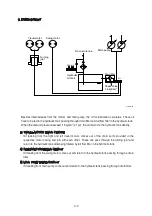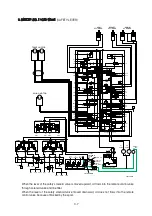
2-81
2-81
2. FUNCTION
FUNDAMENTAL FUNCTIONS
The pilot valve is a valve controls the spool stroke, direction, etc of a main control valve. This
function is carried out by providing the spring at one end of the main control valve spool and
applying the output pressure (secondary pressure) of the pilot valve to the other end.
For this function to be carried out satisfactorily, the pilot valve is composed of the following
elements.
Inlet port (P) where oil is supplied from hydraulic pump.
Output port (1, 2, 3 & 4) to apply pressure supplied from inlet port to ends of control valve spools.
Tank port (T) necessary to control the above output pressure.
Spool to connect output port to inlet port tank port.
Mechanical means to control output pressure, including springs that work on the above spools.
FUNCTIONS OF MAJOR SECTIONS
The functions of the spool (8) are to receive the supply oil pressure from the hydraulic pump at its
port P, and to change over oil paths to determine whether the pressure oil of port P is led to output
ports 1, 2, 3 & 4 or the output spool to determine the output pressure.
The spring (6) works on this spool to determine the output pressure.
The change the deflection of this spring, the push rod (14) is inserted and can slide in the plug (21).
For the purpose of changing the displacement of the push rod through the cam (27) and adjusting
nut (32) are provided the pedal that can be tilted in any direction around the fulcrum of the cam (27)
center.
The spring (10) works on the casing (1) and spring seat (7) and tries to return the push rod (14) to
the zero-displacement position irrespective of the output pressure, securing its resetting to the
center position.
This also has the effect of a reaction spring to give appropriate control feeling to the operator.
1)
2)
(1)
(2)
(3)
(4)
(5)
















































